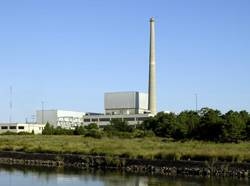The US Nuclear Regulatory Commission is reporting that an “alert” has been declared at the Oyster Creek Nuclear Generating Station in Ocean County, New Jersey. An alert is the second level on the four-point scale, a step above an “unusual event.”
The NRC declared the alert at 8:45 PM local time, as a combination of rising tides, wind and the storm surge from Hurricane Sandy caused water to rise above safe levels in the plant’s water intake structure. Sandy, which made landfall at around 8 PM in southern New Jersey with 90 mph winds, has caused power outages and widespread flooding along the Atlantic coast from Maryland to New York.
Oyster Creek is the oldest operating commercial reactor in the US. It is a GE boiling water reactor of similar design to the ones that failed in Fukushima, Japan during 2011’s Tohoku earthquake, though Oyster Creek is actually older. As Sandy moved up the coast, fears were raised about several nuclear facilities in the storm’s path. The NRC had issued no specific directives in advance of the hurricane, though extra inspectors were dispatched to threatened plants early on Monday.
Particular concerns were raised about Oyster Creek. The reactor is currently offline for maintenance, which means all the reactor fuel, along with generations of used fuel, is in the plant’s spent fuel pools. The plant itself is not generating any electricity, and so is dependent on external power. If the power were to fail, there would be no way to circulate cooling water through the pools.
Backup diesel generators typical to this design power the heat transfer from the reactor, but the so-called “defense in depth” backups for the spent fuel pools are the plant’s own electrical output and power from an external grid.
Flooding of the coolant intake structure further complicates matters. Oyster Creek does not have a cooling tower (like those seen in classic pictures of Three Mile Island). Safe temperatures are maintained by taking in massive amounts of water from a nearby source (in this case, Barnegat Bay). Water must continue to circulate in and out of the facility to keep temperatures at safe levels.
Another question would be whether floodwaters would carry additional radioactive contamination into Barnegat Bay as they recede.
In the NRC press release on Oyster Creek (PDF), the regulator also noted (with apparent pride) that no reactors had been shut down because of Hurricane Sandy. However, at least one reactor, Millstone 3 in Connecticut, had reduced output in anticipation of the storm. Several other reactors in the region are currently offline for refueling or maintenance.


You must be logged in to post a comment.